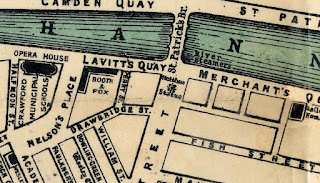Sergeant William Gloster was a Kerryman who served with the RIC in Cork city for many years. He was stationed at the College Road RIC Barracks and lived with his wife Eleanor and four children on St Brigid's Street, just off Barrack Street.
The former RIC Barracks on College Road
St. Brigid's Street
Just before he retired in 1920 Sergeant Gloster had been stationed in the Elizabeth Fort Barracks on Barrack Street and he moved his family from St Brigid's Street to the living quarters in the fort.
The former RIC, and later Garda, Barracks inside Elizabeth Fort.
Police inside the Elizabeth Fort Barracks.
Just after 1 o'clock on the afternoon of the 25th of March 1922 the retired RIC Sergeant was walking down the Grand Parade. He turned down Old Post Office Lane heading towards South Main Street.
Old Post Office Lane (no longer in use) connected Grand Parade with South Main Street.
Sgt Gloster then made it over South Gate Bridge and just as he stepped off the footpath to walk up towards Barrack Street a number of young men who were sitting on the wall near the bridge drew guns and fired at him.
The scene of Sgt Glosters shooting. As he stepped off the path, gunmen sitting on the wall behind drew their guns and shot him.
One bullet hit Glosters head, three more entered his body. The gunmen fled the scene as firemen from the nearby Sullivan's Quay Fire Station came to the aid of Sergeant Gloster and brought him to the Mercy Hospital but the 54 year old Kerryman was already dead.
South Gate Bridge
The funeral of Sgt Gloster took place at St Finbarres Cathedral Cork before his remains were brought back to his native Kerry and he was buried at the old Molahiffe Graveyard near Farranfore.
Then & now: The bottom of Barrack Street, at the South Gate Bridge - the scene of Sergeant Gloster's shooting.
The shooting caused shock in the area as he was considered well liked and apparently even aided local Republicans by warning them of impending raids. The shooting of Sergeant Gloster was condemned by the Cork IRA.
This was a volatile time as the Civil War was brewing. The transition from British rule to Free State rule was occuring and in between these cracks a breakdown in discipline seeped in. Locally it was suggested the killing of Sergent Gloster was carried out by reckless youths who shot him in the wrong.




























































